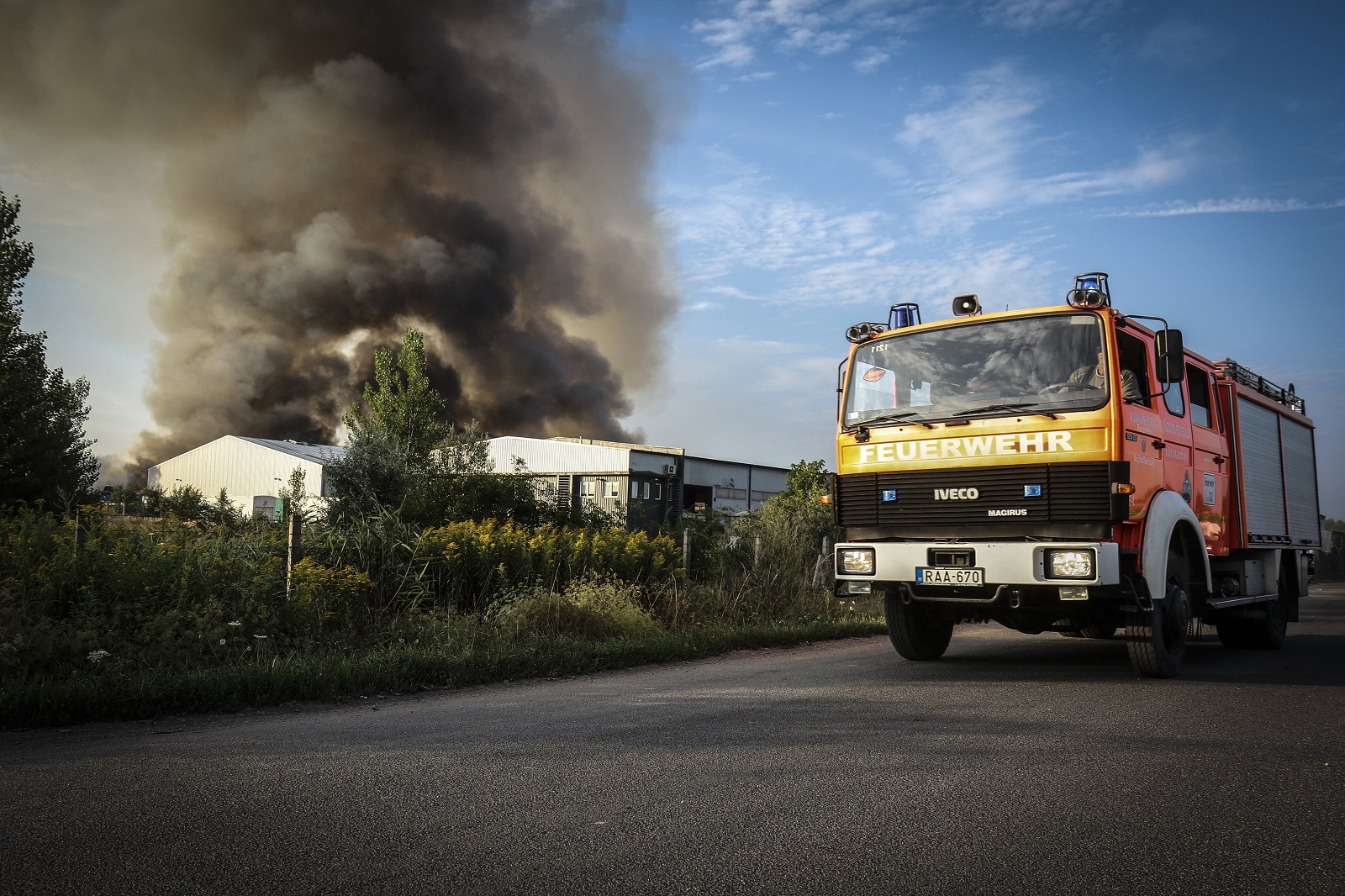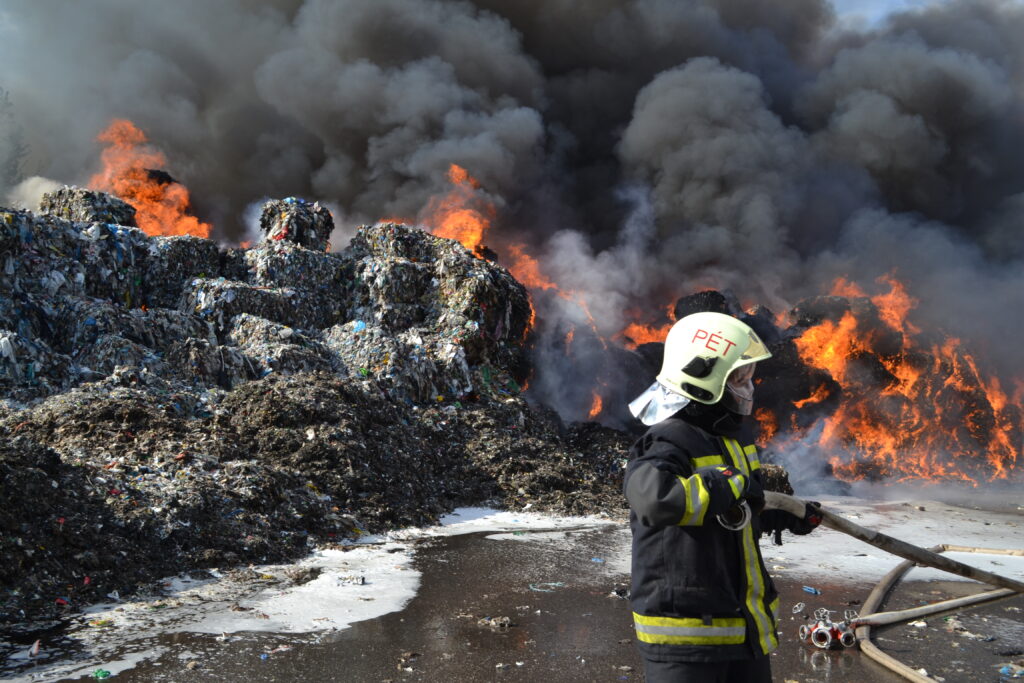The https://english.atlatszo.hu use cookies to track and profile customers such as action tags and pixel tracking on our website to assist our marketing. On our website we use technical, analytical, marketing and preference cookies. These are necessary for our site to work properly and to give us inforamation about how our site is used. See Cookies Policy
Waste facilities in flames – What is behind the landfill fires in Hungary?
For more than seven months, we have been trying in vain to find out from the relevant authorities how often waste fires have occurred in Hungary in recent years. In several negative replies, the National Directorate General for Disaster Management has said that they do not collect such data. However, with the help of our reader and a technological solution, we finally obtained the data from a public, online, but unsearchable database – run by the National Directorate General for Disaster Management. According to the data collected, there have been 350 fires at landfills, waste storage sites, waste treatment plants, waste processing plants and illegal dumps in Hungary in the last six years. Research has shown that the significant emissions of burning waste can pollute the environment and public health for more than 100 kilometres. We show the fires on data visualisation.
We searched the archived entries of the National Directorate General for Disaster Management’s online event calendar for the keywords waste, garbage, landfill, dump, storage and fire. According to the results of our search, there have been 350 waste fires in Hungary between 10 July 2017 and the publication of this article. In 2022, there were 87 incidents when waste went up in flames, an average of one waste fire every four days. In 2021, 55 incidents of major waste fires in the country were recorded, 41 in 2020, 57 in 2019 and 72 in 2018. Most of the incidents occurred at the landfills in Jánossomorja and in Polgárdi. The longest fire event lasted for three days, in August 2019 at the Királyszentistván landfill. In several fire cases, probably waste dumped illegally caught fire, typically in suburban areas. The location and date of the fires are shown in our data visualisation (in Hungarian only):

Harmful substances are released into the air
Of the 350 fire reports, 34 claimed a mobile laboratory from the emergency services was “on the move” or arrived “on the spot” to measure air pollution caused by the fire. However, the results of the measurements are typically not reported, and even when they are, they claim “no harmful levels were detected”, “no harmful substances were detected in the air” and “no harmful substances were detected in the air above the health limit”.
However, the combustion of waste always releases harmful substances into the air, thus it is certainly not possible to say that no harmful substances have been detected in the air. It may be true that the concentration of pollutants did not exceed the limit value, although it is not clear what substances were tested by the mobile laboratory, or exactly at what time, where and for how long. It is also claimed that no limit was exceeded in the 2019 fire in Királyszentistván which burned with huge black smoke and could not be extinguished by firefighters for three days. However, according to the residents we interviewed at the time, this is not very plausible, and when they asked for measurement data in a freedom of information request, it became clear that the authorities had not measured anything.

Királyszentistván, 2019. augusztus 10.
A királyszentistváni hulladéklerakóban keletkezett tűz füstje száll fel 2019. augusztus 10-én. Közel ezer négyzetméteren ég hulladék, az oltásán több mint nyolcvan tűzoltó dolgozik.
MTI/Mátyus Tamás
During waste combustion, carbon monoxide, carbon dioxide, nitrogen oxides, sulphur dioxide, methane, hydrogen chloride, aerosols and even metals such as lead, mercury, arsenic, etc. are released into the air. Of these, aerosols are among the most harmful pollutants, especially particulate matter with a particle size of 10 microns or less (PM 10 and PM2.5), because they pass through the pharynx and even into the lungs and are difficult to get out. Thus, aerosols cause respiratory (asthma, chronic tracheitis) and cardiovascular diseases, and above a certain concentration they mean a quantifiable increase in the risk of death. It has been estimated that particulate matter is responsible for the premature deaths of around 2,500 Budapest residents each year.
Specifically regarding landfills: in a study two years ago, researchers looked at the impact of 79 large waste fires in Poland in 2018. They found that the 79 landfills which caught fire emitted as much methane as the entire Polish chemical industry emits in a full year of chemical production. The carbon dioxide emissions from the 79 fires were comparable to the total annual emissions of a 5 GW lignite power plant, and the amount of particulate matter (PM10) emitted was similar as the emission of the transport sector in Berlin and its agglomeration in one year.
Why do waste facilities catch fire?
Gyula Garanandra, managing director of Rekultív Hungary Environmental Services Ltd., the operator of the municipality-owned Jánossomorja landfill, said that “in B3-type landfills, such as the Jánossomorja Regional Landfill, a significant amount of organic waste is landfilled, which decomposes to produce landfill gas, which is combustible. Much of the landfilled waste is also combustible.”
Specifically, the fires in Jánossomorja are said to have been caused by the fact that, in the past, under the previous administration, landfill management tasks were carried out in an unprofessional manner, for example, regular land clearing was not carried out properly or at all, and the resulting oxygen entering the landfill body fed the fire. In addition, the former landfill gas utilisation contractor did not properly recover or dispose of the resulting landfill gas, which also fed the fire.
Organic waste also played a role in the fires at the Királyszentistván landfill: the fire in August 2019 started in the biological hall, where organic material was sorted and treated (since one of the goals in Királyszentistván was to prevent organic material from ending up in landfill). However, the fire spread from the biological hall to the secondary fuel bales stored nearby, i.e. waste that had already been sorted and was suitable for use in power plants. This is state property and the state company (NHKV ZRt. at that time) has often not removed these bales from the waste facilities for a long time or at all.
Gyula Garanandra confirmed that “in many cases in the past, there were indeed logistical problems with the treated and separated SRF/RDF waste throughout the country. The long-term storage of these materials at landfills was a particular fire hazard, and in many cases they really went up in flames.” According to the manager, the problem lies in insufficient recovery capacity, as not all of the power plants are currently capable of recovering energy from these wastes. Therefore, although the public utilities are required to produce and deliver these wastes for recovery, the state company had nowhere to take them.

Gyál, 2023. március 28.
Lángokban áll egy hulladékfeldolgozó telep Gyálon 2023. március 28-án. Papírbálák gyulladtak ki, és az így keletkezett tűz átterjedt egy csarnok jellegű tárolóépületre, illetve egy betonsilóra, melyben feldolgozásra váró műanyag-darálékot tartottak. Több ezer négyzetméteres terület áll lángokban.
MTI/Koszticsák Szilárd
Fires frequently occur at the Polgárdi landfill site too. Mayor László Nyikos told us that the problem is partly caused by hazardous waste thrown into the municipal waste and thus ending up in the landfill, such as spray cans, bottles, batteries, other flammable materials, and even smouldering ashes from stoves. According to him, in Polgárdi, serious fires at the landfill were more frequent when large amounts of extra waste were temporarily diverted to the landfill due to the development of other waste facilities.
However, the mayor also claimed in an earlier Facebook post that “materials to be recycled or deposited for energy production and awaiting disposal are catching fire with increased frequency. (…) It is important to note that neither municipal waste nor hazardous waste was burnt in the last case. It was other recyclable fractions, already bundled in bales and awaiting further recovery, that caught fire.”
The problem of secondary fuels is also addressed in the “National Waste Management Plan 2021-2027” which states that “the quality of secondary fuels needs to be improved and, due to the lack of storage capacity, the consistency of production, transport and the use needs to be increased. Otherwise, the recovery of RDF waste produced under the public service scheme and prepared for energy recovery will be only partially feasible.”
Not just a Hungarian problem
According to an article from 2017, there were more than 300 incidents of waste incineration plant fires in the UK every year between 2001 and 2013. According to Polish data, between 2017 and 2022, there were 754 fires at waste collection sites in Poland, including illegal dumpsites.
György Szabó, Programme Manager of the HUMUSZ Association, shared with us a number of examples from abroad. Many of these are caused by illegal waste export/import or illegal waste management within the country, and in many cases there is suspicion of intent. An example is the case in Latvia years ago, where illegally stored plastic waste caught fire on the premises of a company that officially wholesales coffee, cocoa and tea. “Presumably they collected the waste, collected the money for this ‘service’ and then didn’t know what to do with it, so they set it on fire,” explained György Szabó.
Illegal waste imports have also been a problem in Poland in previous years. “Often these fires were deliberate, but presumably the majority of cases took place in illegal landfills. Most of the waste was imported from abroad, as this can be a very good business.” The business model is, broadly speaking, that it is more profitable for a foreign waste manager to pay, say, a Polish waste manager than to treat waste in his own country. And it may be cheaper for the recipient to burn it than to treat and dispose of it properly. Polish waste imports and the number of fires rose sharply until 2018, but the restrictions introduced since then have eased the problem.
In Hungary, problems are aggravated by the fact that the waste management system underfinanced. “The system is still missing around 100-150 billion forints a year. The amount allocated to operations is under-estimated, and the eligible costs and applicable fees are not uniform. Major changes are needed in this area, not in the future but as soon as possible, as delays jeopardise the achievement of environmental and waste management objectives.”– says Gyula Garanadra.
Orsolya Fülöp
Cover photo: Médiaszerver, BM Országos Katasztrófavédelmi Főigazgatóság. Data visualisation: Luca Pete. Contributors: Katalin Erdélyi, frontstory.pl and our Reader.

